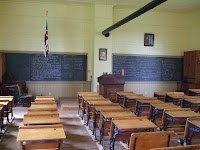 Buxton Museum - Last Stop on Freedom Trail
Buxton Museum - Last Stop on Freedom TrailAudrey and Rod picked up me and my bike and we headed towards Buxton, Ontario. Buxton was our first stop but it was actually the last stop on the Underground Railroad for many fugitives who escaped Freedom and came to Canada.
Buxton was founded by Reverend William King. He was originally from Ireland and immigrated to the US. He married a woman from the south. He came to Canada to start this mission. His wife passed away and he inherited a number of slaves. In addition to these slaves, he purchased some more (one was the son of one of the women slaves he had inherited). He brought them to Canada with the intention of setting them free. He established the Elgin Settlement with the help of Lord Elgin (who the settlement is named after), George Brown and a number of other men of influence. Each family in the settlement purchased a minimum of 50 acres of land at $2.50 an acre and they had 10 years to pay it off. They had specifications on the size and number of rooms of each house - it had to have a garden and a picket fence.

This is a picture of the oldest homestead in existence in Buxton, it was recently restored and is part of the Buxton Museum. The house had to have 4 rooms (pictured are the bedroom and the kitchen)
 Before entering the museum, you can see a replica of the Freedom Bell. It was a gift from the people of Philadelphia. The original is in a church in South Buxton but it hard to see because it is in the bell tower. If you have seen the movie - Race to Freedom with Courtney B Vance, it shows the Freedom Bell in Buxton. It was rung each time a slave made it to freedom.
Before entering the museum, you can see a replica of the Freedom Bell. It was a gift from the people of Philadelphia. The original is in a church in South Buxton but it hard to see because it is in the bell tower. If you have seen the movie - Race to Freedom with Courtney B Vance, it shows the Freedom Bell in Buxton. It was rung each time a slave made it to freedom. When we arrived in the museum, we were treated to the most amazing tour by a direct decent of an escaped slave who settled in Buxton after making it to freedom - Spencer Alexander. He is referenced in the book, Elijah of Buxton that I wrote about yesterday. He showed us around the entire museum and property and told of his fascinating family history. It was an amazing visit back in time.
(click here to find out more: http://www.buxtonmuseum.com/history/hist-ELGIN.html)
 |
| This an auction block you would see at a slave auction or the docks where they would sells slaves like they would other livestock. This picture makes me sad. |
 |
| This is the famous Buxton school house. The only remaining school in Canada built entirely by slaves. |
 |
| The wood stove in the school house. |
 |
| Me - playing teacher in the Buxton school house! |
Tomorrow we head down to New Albany, Kentucky and will camp and then start the cycling portion of the trip. Also planned is a visit to Louisville! Not a stop on the Underground Railroad but a stop because of it's baseball history! We plan to visit the Louisville Bat museum and the home of the Louisville Bats - Slugger Park. I plan to have my picture taken with the Peewee Reece statue. Not a contributor to the Underground Railroad BUT had a big impact during what is known as the Great Experiment in Major League Baseball. He was a teammate of Jackie Robinson - the first player to break the colour barrier in the MLB.





No comments:
Post a Comment